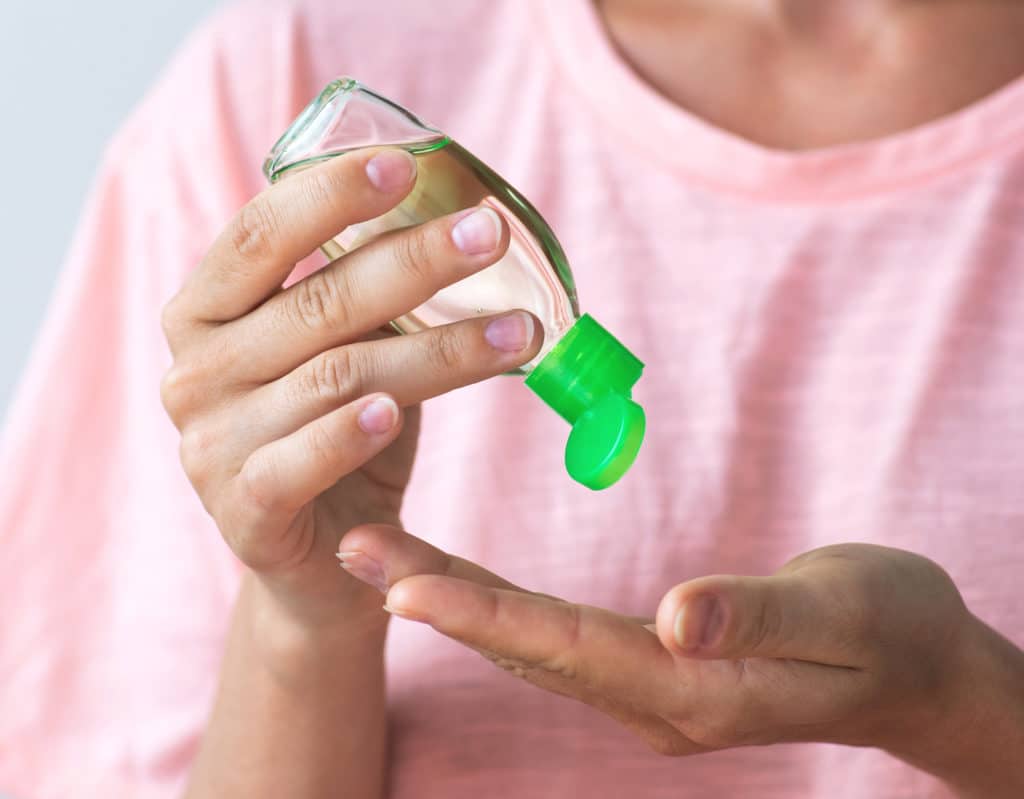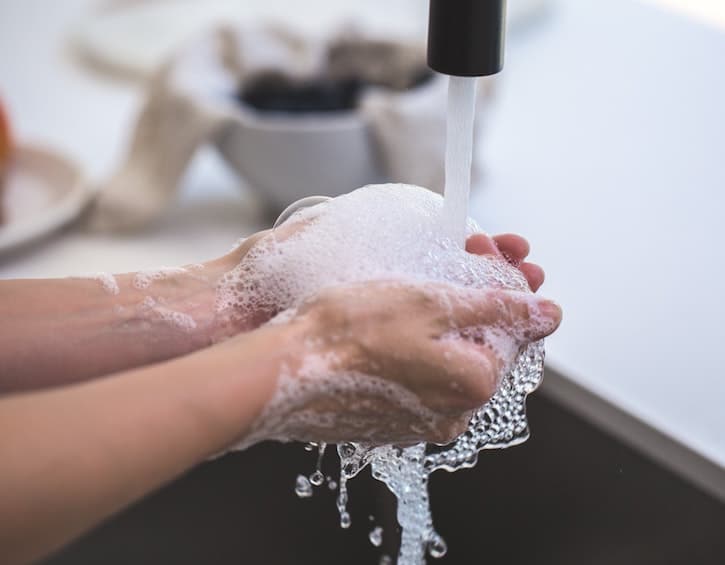
 Post Category - WellnessWellness - Post Category - HealthHealth
Post Category - WellnessWellness - Post Category - HealthHealthShops sold out of hand sanitizer? Make your own germ-killing hand rub with this easy DIY sanitizer recipe!
With news of the coronavirus outbreak, hand sanitizers are now out of stock islandwide in Singapore. Alcohol-based hand sanitizers can reduce the number of microbes on your hands, but sanitizers do not eliminate all types of germs (for example it doesn’t’ kill clostridium difficile or norovirus, which causes gastroenteritis, vomiting and diarrhea).
Your best line of defence against the coronavirus and germs in general is still always to wash your hands with soap and water, rubbing for 20 seconds (that’s two renditions of Happy Birthday for kids to remember). Hand sanitizer also won’t help much if your hands are dirty from soil or oil.
But how do you keep hands clean in between washing your hands – like after you leave a mall and jump into your car? Or when you have been on public transport if there is no bathroom nearby? Kids are bound to touch their face or put their fingers in their mouths no matter how much we remind them not to. So for that reason we like to keep a little bottle of hand sanitizer on hand in the car, another in our handbag, one attached to the kids’ bags – you get the picture! The hand sanitizer needs to have at least 60% alcohol content in order to be effective at killing germs — so read those ingredient lists when out shopping!
DIY Hand Sanitizer Recipe
If you can’t find hand sanitizer in the shops, we have come up with a DIY recipe to make your own hand rub. You only need one core ingredients for this – isopropyl alcohol, the germ killer. You can add in essential oils (we’re loving homegrown essential oils brand Ollie right now) to fragrance your hand sanitizer – we like tea tree oil due to its purported powerful antiseptic and antibacterial properties and some often add in vegetable gelatine or aloe vera gel (to keep your hands moisturized). However for maximum safety we have just been updated that it is best to use straight alcohol so as to preserve the minimum alcohol content in the sanitizer of 60%.
DIY Hand Sanitizer Ingredients
- 1 cup isopropyl alcohol* 70% (we picked ours up at Unity Pharmacy)
- 6-10 drops tea tree oil (optional)
- Spritz bottle
- Add all ingredients to the bottle, close the lid and shake well before use. If your hands are too dry from the alcohol you can wait until all the alcohol evaporates from your hands then add your normal moisturiser.
Important Notes:
– *Do not use Methanol (Methyl Alcohol) if you cannot find isopropyl alcohol – the two are not interchangeable. Methanol is highly flammable and toxic. See note below.
– Care should be taken as due to the alcohol content, this solution is flammable.
– We have recently updated this recipe to take out the moisturising aloe vera gel or vegetable glycerin (available on Amazon Prime) as adding these ingredients brings down the overall alcohol content to below the effective 60%.
– You should also take care to keep any alcohol-based hand sanitizing gel out of the reach of young children as it can be very dangerous if swallowed.
How to use your hand sanitizer effectively
- Place the recommended amount of hand sanitizer (a coin sized amount) in the palm of one hand.
- Rub hands together, making sure the sanitizer gets between fingers and under nails
- Continue rubbing until hands are dry or leave to dry naturally (do not wipe dry).
Where to buy isopropyl alcohol in Singapore?
Look for rubbing alcohol, or isopropyl alcohol, in the shops. There are different types of alcohol content ranging from 60 to 95% alcohol. More alcohol is not necessarily better, as less water content in the formulation can actually hinder the effectiveness of alcohol in denaturing proteins (source). Ispopropyl alcohol can normally be found at most pharmacies however since the coronavirus outbreak, Unity, Watsons and Guardian are often sold out. Do call them to check before going as they are replenishing stock when they can. If you are looking online for alcohol make sure you buy from a trustworthy seller as the alcohol content needs to be above 60% in order to be effective at killing germs and viruses. If you are thinking of raiding your drinks cabinet, do bear in mind that vodka is only 40% alcohol content and the sanitizer needs to be 60% alcohol to be effective.
I can’t find isopropyl alcohol can I use Methanol or Ethanol?
Environmental consultant HuiChing Hia explains: “Alcohol” is a generic term for a class of chemicals that has an -OH functional group. There is the common ethyl alcohol (ethanol C2H5OH, found in our wine, beer and sake), isopropyl alcohol (isopropanol C3H7OH, used for rubbing alcohol) and then there is methyl alcohol (methanol CH3OH, found in methylated spirits). Methyl alcohol is toxic.”
Do not use Methanol (Methyl Alcohol) if you cannot find isopropyl alcohol – the two are not interchangeable. “Methanol is highly flammable (as is all alcohol) and toxic. Direct ingestion of more than 10ml can cause permanent blindness by destruction of the optic nerve, poisoning of the central nervous system, coma and possibly death. These hazards are also true if methanol vapors are inhaled.” (Source).
Can you use ethanol for hand sanitizers?
HuiChing Hia advises that if you can not find isopropyl alcohol you can look for ethanol (ethyl alcohol) which is safe and effective at killing microbes. Your end solution however needs to be 70% alcohol if using ethyl alcohol. “Some industrial ethanol products have a little methanol added to it to prevent people from imbibing ethanol. Please don’t use denatured ethanol/isopropanol for hand sanitizers” HuiChing Hia warns.
Please always check product ingredients before you buy chemicals – if in doubt do not use chemicals that you are not familiar with as the wrong dose or mixing chemicals can be dangerous and toxic.
The best way to stay to keep your hands clean is just keep making sure you wash your hands regularly so don’t panic if you can’t find sanitizer/ingredients.

What’s better: antiseptic wipes or hand sanitizer?
According to Dr Kalisvar Marimuthu (senior infectious disease consultant at the National Centre for Infectious Diseases) as quoted in The Straits Times, “[Antiseptic wet wipes] should be used for cleaning environmental surfaces and not for hands. A virologist from Queen Mary University of London did a study on wet wipes some years back and found that in some cases, using wet wipes actually spreads germs rather than removing them.To be at all effective, the wipes need at least 40 per cent alcohol. Those that are drying out should be discarded.”
And again, just to play repeat, the best thing you can do when you are out and about is always washing your hands with soap and water.
Household Products for Disinfection of COVID-19
If you are looking for household products that are suitable for disinfection of coronaviruses, it’s worth looking on the NEA website for a list household products and active ingredients for disinfection of COVID-19. However bear in mind that as the COVID-19 is new, no study has been conducted directly on the virus. For general precautionary cleaning, NEA says that detergent and water are adequate. For disinfection of areas that are very likely to be contaminated with COVID-19, disinfectant/cleaning products listed on their website can be used.






 View All
View All




 View All
View All










 View All
View All







